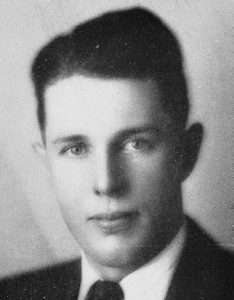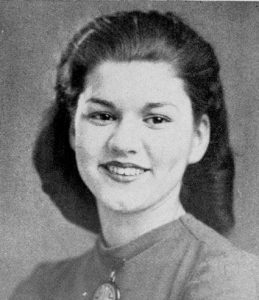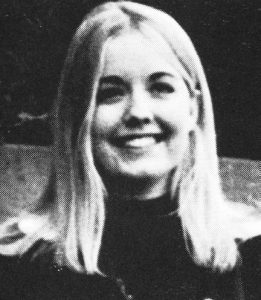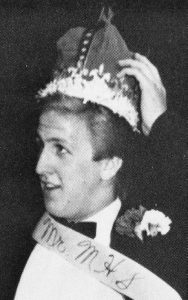By Janet (Krider) Duncan ‘58
This turned out to be a more complex subject than I thought it would be when I was asked the question, “What happened to all the Blue M Queens?” Seeking to perhaps strike a research interest, I mentioned this request to an MHS graduate of the late 80s only to get a blank look and another question, “What’s aBlue M Queen?” So, without all the voting details, which have changed over the years along with the other aspects, here is a chronology as I found it recorded in the yearbooks, with a little Mentor research included. The concept of a single student representing an ideal for MHS does not start nor really end with a Queen.

Blue M Ace
The first photo of a student who was honored by the vote of the entire student body to represent the ideal of MHS was the 1931 Blue M Ace, Charles Finney. (Fig. 1) There are references to an M Club Queen, during these years, but the first Blue M Queen I found pictured, sophomore Dorothy Lancaster, was in the 1939 Blue M (Fig 2.) Students bought their voting right when they reserved their Blue Ms (100 votes came with each yearbook at $0.50.)

‘39 Blue M Queen
The criteria for Blue M Queen changed in 1940: “beauty alone was not to be the only qualification.” She was now to embody the “typical all-round MHS girl.” Personality, cooperativeness and scholarship, as well as appearance, were all to play a role.
Through the ‘40s and ‘50s, with no organized sports for girls beyond intramurals, with no lettering as the boys had or the same level of competition in music or drama or debate, this recognition for girls of an ideal for MHS was indeed an honor. Each year Blue M Queen candidates were selected from Homerooms to represent the finest qualities of attractive school spirit and participation. The final vote became an all student body choice, so from a broad base, the selection of Queen was a girl well respected by her peers. Her identity was revealed at the final school dance of the year when the Blue Ms were distributed with their formal full page portrait of the Blue M Queen. In later decades the Blue M Queens were seniors.

70 Blue M Queen
In the 1960s, with MHS in the new building on Sunset the Homeroom system was gone, so in the fall, girls were selected by the seniors from their class as Blue M Queen candidates. They were introduced at an assembly and an election was then held where the student body voted on five finalists “because of (their) contributions to Manhattan High school.” The Blue M staff then sponsored a Sock Hop in October to announce them and the final election was held in February. Subtle differences occurred through the rest of the decade but the basic symbolism of the Blue M Queen remained the same and Lynn Espeland was chosen in 1970 (Fig. 3).
The 70s proved a time of change. After discussions through ‘71, the 1972Blue M staff abolished the Blue M Queen. The 1973 Blue M staff questioned the ’72 decision, and asked the MHS student body; Should the Blue M Queen be revived? YES, was the decision, and they elected Blue M Queen Sue Remple, with minor photo treatment in the yearbook.
The issue wasn’t over, though. In 1974 the Blue M staff wrote. “In a school with so many varied activities, one individual could not represent a cross-section of high school life.” They decided to honor five girls, instead of one. Ten semi-finalists were chosen; seniors each got 10 votes while the rest of the student body got five votes toward the final selections. And a boy could be elected as a write-in candidate.
1975 saw another change. Tradition was dead; long live the Blue MQueen and King. Five senior boys and five senior girls chosen in the fall by their classmates “for their influence on those who surround them” and for their time and talent given to the school, were asked four questions prepared by theBlue M staff: 1. What qualities should theBlue M King or Queen possess to represent MHS? 2. What do you like about MHS? 3. If you could change something, what would it be? 4. What advice would you give to students, past and present, to get the most out of MHS? The entire school voted in the spring, but I found no sports Honoraries.)
picture in the ‘75 yearbook (although there were photos of the Multiple Blue M Honoraries, chosen for their “outstanding participation in extra- curricular activities,” were back through 1979. This was the building expansion year when the freshmen were moved up from 10th and Poyntz. The yearbook shows a Blue M Dance with a King and Queen from the junior class on the dance floor, but no single pictures or descriptions.
1980 ushered in a new decade by again bringing the Blue M Honoraries back and having the largest group: ten senior boys and ten senior girls chosen as “a group of people recognized by the entire school to represent outstanding individuals in the senior class.” In 1981, the Blue M staff dropped back to five senior girls and five senior boys from those who devoted “significant time to various school activities” and who would be “remembered in the future.” The system stayed relatively the same through 1984.

86 Mr MHS
The Blue M in 1985 shows no one: no Blue M Honoraries, Queen or King. This yearbook omitted other activities, but unless other information turns up, the 1984 Blue M Honoraries may be the final group. The only Honoraries shown in later yearbooks are for Homecomings.
But the idea of one all-round representative of school spirit, participation, and talent was rattling around in MHS, for in 1986 the first annual Mr. MHS contest was organized (Fig 4.) Mr. MHS provides a riotous evening for those who buy admission tickets and cast their vote that evening. MHS boys apply to compete in categories of personality, talent, swimsuit and/or evening wear. Each area is judged on originality, stage presence, and appropriateness. Swimsuits have been scuba gear, barrels, etc. (shades of the old M-Club assemblies).
From the Blue M Ace, to Blue MQueen, to Brock Everett many girls, to girls and boys, to no one, and now Mr. MHS, the idea of representing the school may just have gone through different delivery systems. (The next change does seem perfectly obvious, does it not?)